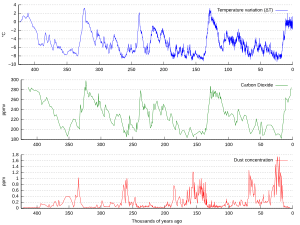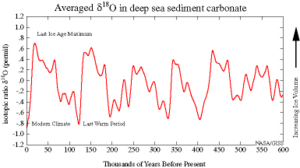Orbital forcing facts for kids
Imagine our Earth spinning and orbiting the Sun. It doesn't always do this in exactly the same way! Over very long periods, the Earth's path around the Sun and its tilt can change slightly. These slow, natural changes are called orbital forcing. They can affect how much sunlight reaches different parts of Earth, which then influences our planet's climate.
Scientists believe these changes are a big reason why Earth has gone through many ice ages. The timing of past ice ages matches very well with what we expect from these orbital changes.
Contents
Earth's Wobbly Dance Around the Sun
The changes in Earth's orbit and tilt are known as Milankovitch cycles. These cycles were first described by a scientist named Milutin Milanković. He figured out that three main things happen to Earth's movement:
The Shape of Earth's Orbit (Eccentricity)
Sometimes Earth's path around the Sun is more like a perfect circle. Other times, it stretches out into a slightly oval shape. This change in shape, called eccentricity, happens over about 100,000 years. When the orbit is more oval, the distance between Earth and the Sun changes more throughout the year. This affects how much sunlight Earth receives.
Earth's Changing Tilt (Obliquity)
Earth is tilted on its axis, which is why we have seasons. But this tilt isn't always the same! Over about 41,000 years, the tilt changes slightly. It can go from about 22.1 degrees to 24.5 degrees. When the tilt is greater, the seasons become more extreme. This means hotter summers and colder winters. When the tilt is less, the seasons are milder.
Earth's Wobble (Precession)
Think of a spinning top that slowly wobbles. Earth does something similar! Its axis slowly wobbles, pointing to different parts of the sky over time. This wobble, called precession, takes about 23,000 years. It changes when Earth is closest to the Sun during its orbit, which can affect the strength of the seasons in different parts of the world.
How These Cycles Affect Climate
These three Milankovitch cycles work together. They change the amount of sunlight reaching Earth, especially at middle latitudes (like where most continents are). This can change the sunlight by as much as 25%!
When we talk about "forcing" in this context, it means a natural process that pushes or pulls Earth's climate in a certain direction. These orbital changes are a "forcing" because they are a strong, natural influence on our climate.
Ice Ages and Milankovitch Cycles
Scientists have studied ice cores (long tubes of ice drilled from glaciers) and ocean sediments. These give us clues about Earth's past climate. The data from these studies show a strong pattern: ice ages tend to happen every 100,000 years, which matches the main Milankovitch cycle.
Look at the first graph (Vostok Petit data). You can see how the temperature (blue line) and carbon dioxide (green line) go up and down in a strong 100,000-year pattern. You might also notice something interesting: the ice ages seem to get colder step by step. But when they end, the Earth warms up very quickly in one big jump. This is called "asymmetry" because the cooling and warming don't happen in the same way.
These cycles help us understand why Earth's climate has changed so much over millions of years, leading to periods of vast ice sheets and warmer interglacial times like today.
Images for kids



